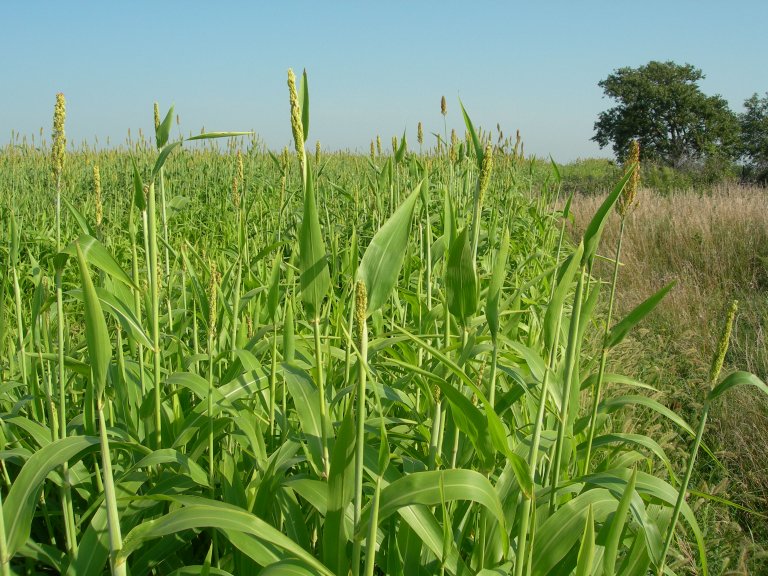
By Aaron Berger, UNL Extension Educator
Wheat harvest in Nebraska will soon be upon us. As drought conditions continue in Nebraska it appears there will be quite a bit of demand for hay and forage this fall and winter. This may lead many producers to consider what annual forages could be planted into irrigated wheat stubble in western Nebraska in July and August.
Summer annual forages such as sudan grass, sorghum x sudan hybrids, pearl millet, foxtail millet and teff are all options for producing additional forage. Determining the best option for your operation will depend on water availability, individual goals, available harvesting equipment and when forage is needed.
Foxtail millet and teff would be an excellent choice for one cutting of hay or for windrow grazing. A sorghum x sudan hybrid would be the first choice for a crop to chop as silage, while pearl millet and low-prussic-acid varieties of sudan grass would be good choices for grazing. Summer annual forages should be planted by July 20. If you're planting after this date, spring annual forages such as oats, spring wheat and spring triticale might be a good choice instead of summer annuals. Oats, spring triticale or spring wheat are usually thought of as a spring crops, but when planted in late summer with adequate moisture, they can provide high quality forage for direct grazing, windrow grazing or for hay. Research has shown that spring annuals can accumulate approximately two tons of forage per acre into late October when planted in early to mid-August. Oats are somewhat cold tolerant and can withstand light frosts and temperatures down into the upper 20’s before growth ceases. A number of producers in western Nebraska have planted oats into wheat stubble and found that it can provide excellent grazing into the winter. Weaned calves, replacement heifers, and bred heifers are all classes of livestock that can benefit from this high quality feed.
A NebGuide entitled “Utilizing Annual Forages with Limited Irrigation for Beef Cattle During and Following Drought” (http://go.unl.edu/8nb)is an excellent resource outlining the advantages and disadvantages of different annual forages. It is available online or from your local Extension office.
The critical thing to consider about summer annual forages is the remaining length of the growing season. Long-range forecasts from the National Weather Service's Climate Prediction Center (http://www.cpc.ncep.noaa.gov/) are available for producers to consider as they make decisions about which forage to plant.
If you are looking for grazing for this fall, winter, and for next spring, planting a combination of oats/turnips and triticale or rye could be a good option as well. The oats and turnips will winter kill while the triticale or rye will over winter and be available as a forage source next spring.
In the summer of 2012, oats, sorghum-sudan, and foxtail millet were planted into irrigated wheat stubble at the High Plains Ag Lab north of Sidney after wheat harvest with an early and late planting date of July 18 and August 2. These three forages are commonly grown in the Panhandle for forage both under irrigation and on dryland. In addition to planting dates, four and eight inches of irrigation water were applied across the planting date treatments.
As would be expected with the heat and dry conditions we had last summer, the amount of irrigation water that was applied was critically important to the amount of forage that was grown. The early planted sorghum-sudan grass with 8 inches of water produced the most total forage per acre when all the forages were harvested on September 18. Oats was second and foxtail millet was third in terms of total pounds of forage produced per acre across the treatments. Due to the early wheat harvest that occurred in 2012 along with the weather conditions that favored the sorghum-sudan, it is logical that it performed as well as it did.
Areas of the forage plots were left standing through the winter and clip samples were taken in early March to measure forage quality change. This data is still being analyzed and results will be available in the future. This study is going to be repeated in 2013 to see how weather and planting dates may impact forage production in different years. To learn more about this study and see the site where the research occurred, please plan to join us at the 2013 High Plains Ag Lab Field Day in August.
With the expected high demand for feed this year, planting annual forages into irrigated wheat stubble may be a good option this year. Due to the ongoing drought, annual forage seed is in short supply, so be sure to secure your seed early if you are planning on planting annual forages into wheat stubble.
For more UNL Beef information to to http://beef.unl.edu